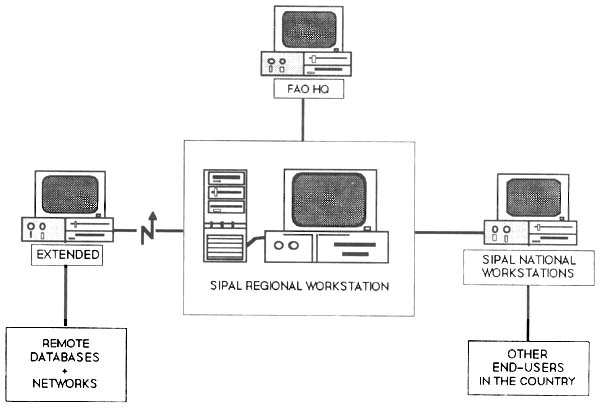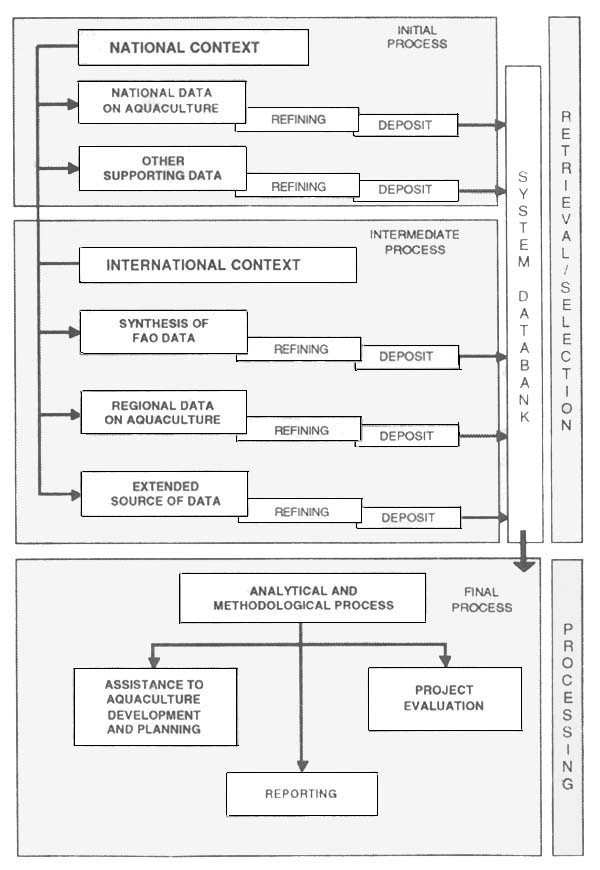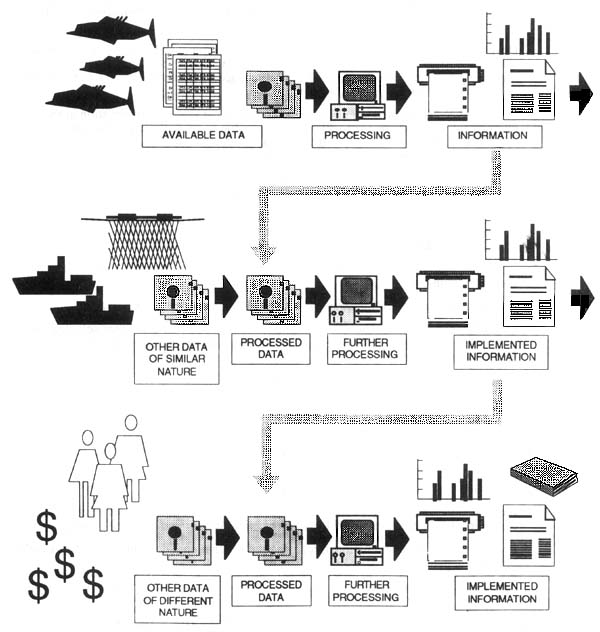The Conceptual Design phase must identify the objectives and requirements of the SIPAL Information System.
This is a delicate phase because it immediately precedes the very important one of system analysis where the objectives and justifications have to have been already defined. The system analysis phase will, in practice, define the feasibility and at what cost (in terms of resources, risks, etc…) the project can be implemented.
Once the objectives and goals have been defined, the information system SIPAL can be seen as being made up of the following components:
a predefined architecture,
a set (assembly) of human resources,
a set of automatic and manual instruments for the collection, aggregation, retrieval and processing of data,
a set of procedures and techniques to meet the objective,
a predefined data-information model.
As described in the following section, the System will be constructed using a totally open architecture, i.e., a modular architecture. SIPAL will be composed of “blocks”, each defined by its area of application. The blocks will not be bound to interact to specific external specifications (hardware/software); instead, it will be possible to tailor each block to different external formats as necessary according to the interfacing systems (hardware/software platforms) all converted to the same format.
This approach has the advantage of enabling the System to be developed stepwise with the possibility of adding to and expanding the elementary modules. It also enables more than one building team to work on different parts of the System independently and simultaneously. In fact, in the development of the overall System, different tasks will be assigned to different units.
The SIPAL Structural Hierarchy will be based on an Open Menu Architecture System to manage a collection of five Base Modules as well as two Accessory Modules. For the description of each module, please refer to section 2.1., The Objectives.
Each Module is a collection of many elements each representing one stand-alone application of various types:
Each Element of the Base Modules will consist of three standardized functions:
The data/information flow will be constructed around a star-like organization (see 3.3) of the National Workstations set up according to the following channels:
| From/to | SIPAL National Coordinator Workstations with SIPAL Regional Workstation |
| From/to | FAO-HQ with SIPAL Regional Workstation |
| From/to | SIPAL National Coordinator Workstations with End-Users |
| From | Remote databases To SIPAL Regional Workstation |
| From | External Networks To SIPAL Regional Workstation |
| From/to | Remote SIPAL Users with SIPAL National Coordinator Workstations |
| From | keyboard To SIPAL Workstations (direct inquiries) |
Import/Export Data will also follow a pre-established time pattern. Data should be captured, compiled, normalized and distributed for three different time schedules:
Yearly/monthly, for static and little dynamic data.
Weekly/daily, for dynamic data.
Occasionally, for permanent data (Reference Files), occasional data, etc…
and constitute three different uploading/downloading procedures. Data uploading and downloading must be made according to type, frequency and use of the information, regardless of whether it is aquaculture data, fishery data or complementary data.
For the development phase of SIPAL, the System Designer will also act as System Manager in order to ensure consistency and give continuity to the concepts introduced in this paper; moreover, he will coordinate the SIPAL Reference Manual and the SIPAL Installation Manual documentation. The terms of reference of the System Manager, who will be in charge of SIPAL once AQUILA II terminates, are given in Annex 3.
Three major components are normally involved in the design and implementation of any information system:
Design Unit
Developing Unit
End Users
In the SIPAL concept, the above become reorganized as follows:
Each of the applications to be developed (elements) will be considered as stand-alone applications with certain input/output or linkage constraints to be fitted into each of the modules.
The design unit is composed of the following:
This group of experts, coordinated by the SIPAL Data Manager, will decide which applications should be developed and the priorities, as and when required.
This task must be considered of vital importance for the life of SIPAL.
The form in which the data are to be produced and submitted, their frequency of production, and how they are to be processed and analyzed needs to be discussed and agreed to at interest group level. One of the means of supporting the interdisciplinary application proposal should be the extension of the many workshops on various subjects organized by the regional Project. This should consist of adding, whenever possible, an additional item (possibly before Conclusions and Recommendations to the agenda of the workshops to ensure that the appropriate variables needed are identified, regularly collected through agreed methodology, and delivered to SIPAL at regular intervals, and finally that this procedure is maintained.
It should be stressed, however, that the underlying concept of a Regional Data Bank would be that all data and information produced should be of proven utility both to national and regional users involved in research/management/planning.
Once an application is identified, the design unit will prepare in detail the Application specifications as a project format which should contain inter alia:
Description and objective: stating why that item was considered to be of particular interest.
Variables to be considered: type of data, units, collection method, reporting frequency.
Possible source of data.
Users of particular relevance.
Data entry format.
Data manipulation.
Data retrieval functions.
Data output format.
Suggestions.
Constraints.
The SIPAL System Designer should assist this unit at the beginning in order to establish a consistent working method and then finalize and document it in the SIPAL Reference Manual paper. While it is not important that the data processing expert assist the unit at the outset of the work, this will be one of the main tasks of the Data Manager.
To be successful the design unit should foresee the optimum that can be obtained from a certain type of data/information, and design the input/output requirements as if they were to be carried out manually. It is also recommended to always bear in mind the scope, type and nature of the data to be entered into the system.
Once the Application has been conceived, the Analyst and/or Programmer will translate the requests into a software tool. At this moment modifications or suggestions may be incorporated into the original design.
For the successful implementation of this work it is imperative that the project provides the services of a full-time Data Manager. This person, who does not necessarily need to have informatics or aquaculture qualifications, will ensure the correct and timely execution of all the phases of the program for the development and implementation of this system. The terms of reference of this officer are given in Annex 4.
In addition to the Data Manager, the project has to foresee the following personnel input.
Contract for a computer programmer to assist in assembling the FAO Module into SIPAL (based in Rome FAO HQ).
Analyst-Programmer to ensure the system maintenance, undertake data downloading/uploading, train regional and national experts in the use of SIPAL, participate in the development, improvement and maintenance of the system (based in Aquila HQ). Terms of reference are given in Annex 5.
Consultants to prepare reports and technical material.
Each country participating in this activity should involve national aquaculture planning and computer programming experts in this exercise as required.
The end-users can be classified by group according to the position they occupy and the field of their interest. The major end-user group is the staff of the fisheries and aquaculture service in the various national offices in the Region who will be using SIPAL mainly for reporting and planning purposes, but also to answer queries from their private sector. This group is also the most important one for data supply. Among a second group of end-users are aquaculturists, economists, fishery specialists, investors and traders in the industry, trade, and educational institutions, in both the public and private sectors. The SIPAL National Coordinator should organize its own national end-user group.
This system will be designed as an integrated information system, that is a homogeneous system in which the end-user is not aware that it is built of different basic elements. It is important to note that in designing this system the end-user and his needs, and not the wish to produce one more instrument of data dissemination without a pre-established target, are the main consideration.
For reasons of compatibility with FAO standards, and for other technical and operative reasons, the networking hardware is configured around a platform based on the INTEL 80×86 microprocessor family. The elements that need to be integrated to constitute the network through non-rigid connections are of a different nature and effort.
At the system architecture level national, international and FAO environments used have to be made simple and clear.
At the structure level different connecting protocols (interfaces) to manage products coming from different environments need to be developed both for the input/output procedure and for the format and structure of the data.
At the function/service level data format interchange with applications (standard commercial software) and connection to different peripherals such as printers, scanners, modems, as well as electronic mail, must be foreseen.
At this level the different national working languages to be used in the system must also be taken into account. Therefore, the system will be provided with a multilanguage data dictionary to allow quick and standardized user interfacing.
The system will be developed, both in the center and at the periphery, on identical hardware in order to optimize the products and ensure the network performance. The configurations described in Annex 2 do not necessarily need to be completed at the beginning of the project since they have been designed to be expanded as necessary although they all have to be completed and fully operative by the third phase of the working plan: The SIPAL Prototype (see Chapter 4.).
The system architecture will be designed on a star pattern with non-rigid connection in which the center of the star represents the manager/server and the points represent the users. The System will have two operational levels, one in the center and one at the periphery. For an easier understanding of the above pattern a chart follows (Figure 3). In this particular case the system is developed around a network in which the center of the star is represented by the Aquila II Project headquarters where the Data Manager/server pilots all the applications at regional level. At the edges of this star are the countries and other end-users in the region. The Network is complete with two more connections, one representing the link to the FAO Fisheries Department SIPAL backstopping team as Data/Information Supplier/Receiver, and a second one to an ideal node to connect remote databases and networks.
The above work will be documented in the SIPAL Reference Manual.
The development of the software is strongly influenced by the structural design of this network (star) which has been conceived to allow the integrated system to be developed in a modular way independently from the two levels of implementation. To make full use of the above structure a slightly unconventional approach has been chosen in the development of the system. The first level network which covers the project headquarters, FAO-HQ and the remote centers applies a so-called top-down strategy. This strategy is typical of a vertical initiative in which, without taking too much account of the final characteristics of the user, the application is developed and imposed. For the application of this strategy the initial components (FAO databases and other software with their ‘known’ specifications and environments) of the system are known beforehand. The FAO information module will be developed and implemented using this strategy and will be distributed by the project headquarters to the end-user Workstations.
The National Workstations will manage the flow of the data between the various national sources of data and themselves and will be responsible for the interfacing procedures (installation, training, setting-up, etc…) to the Regional Module. This Module, to be developed in the SIPAL Headquarters (regional information module), will have the dual task of interacting with the project headquarters and with the country. Since this module is strongly dependent on the various national contexts, a bottom-up strategy is applied. For this, a methodology which permits the identification of many simple problems and their solution independently is used. This module will therefore be developed by consolidating and expanding the system, both in dimension and application, as new blocks are added from the bottom upwards. This is a strategy where the analyst does not need to know initially all the situations he will be faced with (different national contexts).
One of the most interesting features of this program of work at the cooperation level is the direct involvement of national personnel and the end-users in the development and system enhancement of the Interfacing Modules. This approach (to use national staff) is considered a basic condition for the success of the program of work during and after project implementation.
The software to be developed is limited to that for the management of the FAO and regional information modules and the input/output protocols for uploading/downloading FAO and regional databases, maintenance systems and the interfaces with the various and different national systems. Towards the end of the project procedures for tele-maintenance and tele-updating via modem through a “carbon copy” approach, both from Rome FAO-HQ and from the project headquarters, should be in place. This approach will allow the System Manager to temporarily control the remote work station through a modem and special software.
Figure 3 - Regional Desk Information Network

The processing function of the system, as well as the word processing, statistical analysis, graphics, project management, etc…, will be carried out in one area of the system (Data Processing Module) which will make use of commercial software possibly standard within the FAO family. This Module may also contain programs and procedures developed by the project to allow standardized and repetitive data processing, report generation, etc… The commercial software may be integrated with built-in macro instructions to perform certain operations.
The analytical and modeling area is to be covered by specific software to be developed once SIPAL is in an advanced phase for modeling type of investments, simulating intervention, assisting in formulating and evaluating aquaculture projects.
For the SIPAL software development, dBASE IV is the selected Relational Data Base Management System, not only because it is an internationally accepted de facto standard, but also because many FAO applications, as well as national applications, have already been developed using dBASE. For the supporting software the use of the following, classified as FAO standard is foreseen:
| • Word processing (multilanguage) | Word Perfect 5.1 |
| • Spreadsheet | LOTUS 123 |
| • Graphics | Harvard Graphics/Draw Perfect |
| • Statistical package | Statgraphics |
| • Data Base Management | dBASE IV (xBASE Family) |
| • Project management tool | MS Project |
| • High-level language | BASICA/PASCAL/C++ |
| (external routines only) | |
| • Data communication | PROCOMM Plus |
| • Aquaculture planning tools | to be decided |
The above packages are acceptable at the time of writing and, in any case, are only indicative and may be changed and/or added to at any moment.
The functional process of the system (Figure 4) will follow the same pattern as the Decision-making Process shown in Figure 2.
Figure 4 - SIPAL Operational Processing Chart

The data information flow will be developed within a strategy defined by a working group, composed of national, regional and project experts, which will indicate the information needed. The major concern here is the possible inadequacy of some national infrastructures to support the proposed strategy and the obligation to provide additional resources for this work. The data/information flow will grow in a selective manner without duplicating existing work already carried out by other organizations/institutions. The members of the working group will be in contact with each other to identify and disseminate information of interest from various national, regional and international sources. At this point the project must make a great effort, both in the research of data/information and in reaching agreement with the various institutions, to obtain authorization to receive and utilize the data/information needed.
In fact, as far as the relationship with FAO is concerned, this subject is regulated by Director-General Bulletin No90/22, and is the object of discussion by a working group set up by the Director-General to give guidelines on this matter. The Aquila II Project will be responsible for obtaining the data/information to feed the FAO Information Module (FAO Computerized Information Series).
Regarding the national data/information to be integrated in the subregional and regional systems (Regional Information Modules), the national coordinators will be responsible for obtaining such authorization. However, the project should prepare a standard draft letter of agreement between the project and the national institution concerned or other supplier of data to be used as a basis.
It is essential for the present and future life of this system that all data entering the SIPAL network be appropriately authorized.
The data/information model used in this system will be of a complex type (Figure 5), i.e., data and information are linked at three levels. At the basic level the data collected through a system is processed and published according to given methodology, standards and frequency (output).
At the second level (sectorial or specialized), some of the information produced at the basic level becomes data (input) to be processed and analyzed together with data and information coming from other sources within the same field.
At the third level (complex model), some of the information produced at the basic and second levels becomes data (input) to be processed and analyzed together with data and information coming from sources of a different nature.
Figure 5 is the complex data information model shown which assembles all three levels.
Figure 5 - SIPAL The Complex Data Information Model
